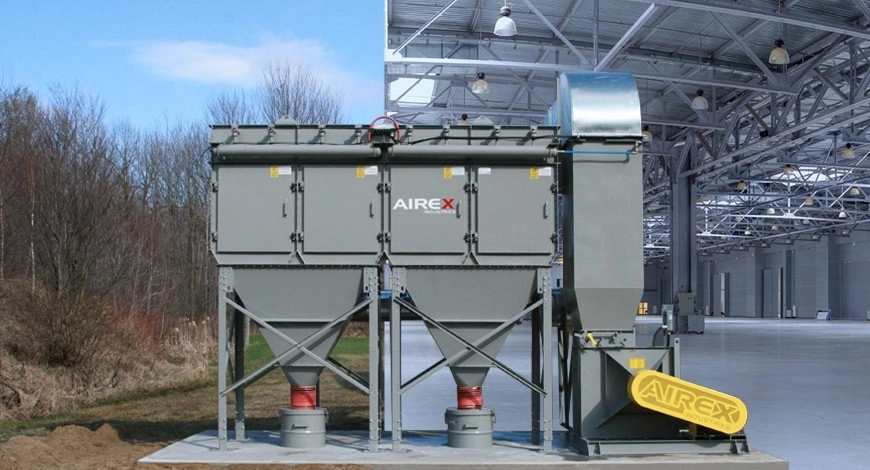
Indoors or Outdoors: Where To Put Your Dust Collector?
Do you need to consider installing or re-engineering a dust collection system? Since the location of your dust collector impacts both its design and the costs associated with designing and operating it, it’s best to really weigh the advantages and disadvantages!
Read our suggested paths for reflection to help you solve this dilemma.
Five Factors to Consider for Making an Informed Decision
In your thinking, bear in mind your processes, their respective locations, and the types of particles produced. Let’s go!
1. Noise
It’s really rare for a plant’s processes to be silent, and a dust collector adds the noise of its fan, motor and, with compressed-air declogging, its pulsations and compressor.
Outside, you could receive complaints from nearby establishments. Noise nuisance legislation and decibel levels must be complied with, especially if you are located near a residential area.
In both cases, you could add an “acoustic cabinet” to contain the noise of your fan and its motor or to covers the diaphragm valves to dampen down the roaring sound from the compressed air jets. Inside, an isolated (but accessible!) room could house your system.
2. Space Management
Ideally, the dust collector should be relatively close to the processes it serves; the shorter the intake ductwork, the less static pressure will be generated. Therefore, the fan needs minimal driving force and uses less energy – a bonus for your energy bill!
However, this option is not always possible. The process is sometimes centrally located in the plant. A dust collector installed nearby could then interfere with the movement of your employees or vehicles. The dust collection system is more often placed near an exterior wall, but that can increase the driving force in order to offset the air stream’s longer travel distance in the ducts.
Although optimizing the plant’s floor space is important, installing the dust collector outside is not a silver bullet solution, as our last two points demonstrate.
3. Fire Protection
In an explosive dust context, managing deflagrations is an integral part of the design. Outside, you may need deflagration vents to release a potential explosion in the dust collector.
If you opt for an indoor location, the protection accessories must be adapted accordingly. For example, with a dust collector centrally located in a plant, solutions limiting deflagration, like a flameless vent or isolation valves, must be put in place. If the dust collector is near an exterior wall, the explosion can be redirected outside. In such a case, the ductwork leading outside must be strong enough to withstand the pressure.
With the right accessories, installing it indoors can be safe. However, it is likely to be more expensive than installing it outdoors.
4. Accessibility for Maintenance
The location impacts the maintenance of your dust collection system, a key aspect of its efficiency and proper operation.
Indoors, if it is isolated, maintenance is more complicated and can even cause industrial accidents. Imagine an enclosed room with other industrial equipment causing interference!
Are you considering putting your system outside? In the summer, installing it is straightforward, but replacing a barrel buried under the snow in an inaccessible corner of your property is another story! Instead, the dust collector could be located outdoors near the building and, – rain or shine – send the particles into a barrel located indoors using a screw conveyor.
And don’t forget:
• Indoors, an additional cleaning phase may be required when replacing the filters.
• Outdoors, the dust can usually dissipate into the air without any problems, except for harmful particles whose air emission rate is controlled.
5. The Impact of Climate
If installed outdoors, the dust collector must deal with our North American climate’s seasonal changes and temperature fluctuations, which can cause significant losses. Have you considered the following two aspects?
1) In a plant, the air can be heated and cooled. This is increasingly the case in establishments in order to avoid interrupting their production during the summer. If the types of particles emitted allow it, that air stream can be recirculated into your facility after filtration in order to avoid wasting energy and money.
2) In the winter, the air temperature can drop several degrees between the intake and outlet of the dust collector (and vice versa in the summer). This cooling can turn the moisture in the air into condensation, which can cause rust in your machine and, when mixed with hydrophilic dust, create a paste that would prematurely clog your filters.
If your system has to be shut down regularly, that condensation could even turn into ice in the winter and damage your system, while slowing down your production. That is to be avoided at all costs!
To prevent these complications, your dust collector could be thermally isolated, and if that is not enough, an electrical heat tracing system could also be added.
Get Everything in Order for a No-Surprises Design
One thing is certain: there is no one-size-fits-all solution! Continue your thinking with our tips for choosing the right dust collector or take a look at this checklist of steps to simplify the preparation of your new air handling project.
